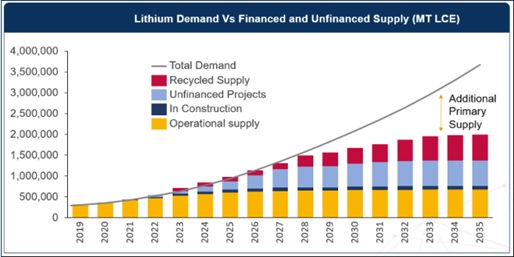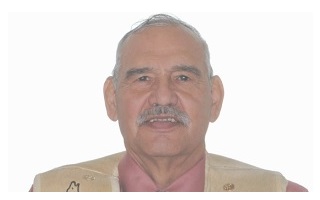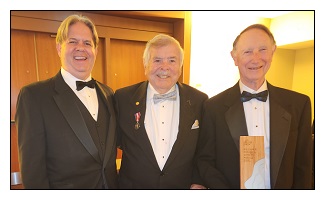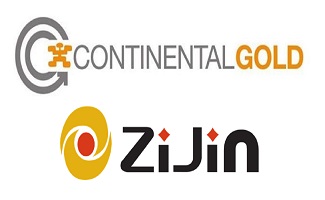eResearch| First Energy Metals Limited (CSE:FE | OTC:FEMMF | DB:DFLB) continues to release drilling results from its Augustus Lithium Project in Quebec as it works toward a NI 43-101 resource that validate historical drilling from the 1950s that reported Lithium Oxide (Li2O) grades in the 1-2% range.
From the historic drilling in the 1950s, the Augustus pegmatite extended more than 850 metres (m) along strike with an average width of 7.6m and an average grade of 1.12% Li2O. The deposit is open at depth, but mineralization was intersected at a depth of 207m.
Based on this historic drilling, if mineralization continuity can be proven by future drilling down to a depth of 200m, a potential resource target of 3.4 million tonnes at 1% Li2O could be achieved, enough lithium for about 1.6 million electric vehicle (EV) batteries.
Lithium mines and exploration projects in the area are of similar grades and support the continued exploration and potential at the Augustus Project.
At the nearby Authier Project, Sayona Mining (ASX:SYA) plans to put its project into production with a deposit that has similar geology and resource grades, albeit with a much larger resource at 57.7 million tonnes. (For more information, see the “Regional” section below.)
Successful Phase 1 Drill Program Supports Historical Results
First Energy Metals has four projects in Canada but is currently focusing on drilling and exploration at its Augustus Lithium Project that contains the Augustus, Canadian Lithium, Valor, and Lac La Motte prospects.
The initial drill program, which was started in April, focused on target areas based on the historical exploration data and the Company’s surface trenching and sampling program. Several historical drill hole collars were located that helped with the location and orientation of the drill program.
In September, First Energy Metals successfully completed its Phase 1 drill program of 5,847m, targeting the Augustus prospect zone. A total of 32 drill holes were completed and 27 holes intersected spodumene-bearing lithium pegmatites.
In its latest drill results, released on December 9, hole LC21-09 intersected a 39m spodumene pegmatite and returned a 7m wide zone that assayed 1.12% Li2O at a drill depth of 11m. The values within the mineralized zones were reported in the range of 0.26% to 2.15% Li2O.
Throughout the year, First Energy Metals released additional drill results that included the following highlight holes:
- LC21-16: 19m of 1.17% Li2O at a drill depth of 126m;
- LC21-05: Two zones of mineralization were returned – 4.0m of 1.47% Li2O at a drill depth of 11.5m and 3.0m of 0.56% Li2O at a depth of 32.0m depth, including a 1.0m long section of 1.14% Li2O at a depth of 33.0m;
- LC21-22: 10.5m of 1.22% Li2O at a drill depth of 69.0m;
- LC21-12: 10m long zone of 1.11% Li2O at a drill depth of 110m;
- LC21-29: The drilling intercepted two lithium pegmatites, 4.2m apart from each other. The top intercept was 6.12m of 1.18% Li2O at a drilled depth of 148.48m and the lower intercept was 5.6m of 1.76% Li2O at a drilled depth of 158.4m.
Historical drill results from the 1950s outline the potential mineralized deposit and compare favourably with First Energy Metals’ recent drill results. Historic results include:
- 41% Li2O over 27 feet (8.23m);
- 25% Li2O over 27.5 feet (8.38m);
- 07% Li2O over 20 feet (6.1m);
- 66% Li2O over 12.5 feet (3.8m); and,
- 69% Li2O over 9 feet (2.74m).
The Company commented that the current work confirmed the historical lithium mineralization reported on the property and helped to define targets for further exploration. The Company plans to complete at least 10,000m of drilling and announced the start of its Phase 2 drill program on December 6.
Channel and Grab Sampling Support Drill Programs and Future Exploration
After acquiring the first lithium property at the start of the year, the Company raised $1.55 million and started ground exploration work that has been running continuously since February. Its purpose was to locate and confirm historical lithium pegmatite occurrences on various historical lithium prospects, to locate historical drill holes on the property completed in the 1950s, and to support the ongoing drill program. The pegmatite outcrops were easily exposed using an excavator for sampling.
Channel and grab sampling throughout the year identified areas of surface mineralization including the following highlight sections:
- Augustus Prospect:
- 32m wide section with an average of 0.74% Li2O that included 14m of spodumene pegmatite with 1.61% Li2O;
- 14m wide section with an average of 61% Li2O;
- 8m wide section with an average of 1.44% Li2O;
- 31m wide section with an average of 0.37% Li2O that included 4m of spodumene pegmatite at 1.20% Li2O.
- Canadian Lithium Prospect, Beluga Pegmatite Zone:
- Three grab samples assayed up to 4.61% Li2O with an average value of 3.04% Li2O.
- Valor Prospect:
- 14m wide section with an average of 0.70% Li2O, including 8m of spodumene pegmatite with 1.14% Li2O.
- Two grab samples assayed up to 3.14% Li2O with an average grade of 2.17%.
- Lac La Motte NE Prospect:
- Two selected channel samples assayed up to 3.01% Li2O with an average of 1.56%.
District-sized Land Package in the Lithium-rich Abitibi Region of Quebec
At the beginning of this year, First Energy Metals started assembling a group of mining claims and land packages in the Abitibi Region of Quebec, Canada, and made a total of four acquisitions.
The total project size now consists of over 300 mining claims covering an area of over 15,045 hectares (over 37,177 acres) with Augustus and Canadian Lithium being the two most prominent lithium prospects.
- Augustus Lithium Property
In January, the Company acquired the Augustus Lithium Property that consists of three non-contiguous mineral claim groups, covering an area of over 627 hectares (over 1,550 acres), and located 40 kilometres (km) northwest of the mining town of Val-d’Or, Quebec.
The Property has good infrastructure support with the availability of electricity, water, and trained manpower, and can be easily accessed by road or train.
The two main lithium prospects on the property are Augustus and Canadian Lithium, which have been explored intermittently since 1948. During the 1950s, 62 holes were drilled on the Augustus Lithium Property, covering a length of 10,000m with 6,024m targeting the lithium prospects.
As previously mentioned, the Augustus prospect mineralization extends for 850m along strike with an average width of 7.6m and an average grade of 1.12% Li2O. The deposit is open at depth, but mineralization was intersected at a depth of 207m.
The Company also believes the Canadian Lithium prospect has a potential for a large volume, near-surface, low-grade pegmatite resource.
- Two Additional Claim Groups; Including More of the Canadian Lithium Prospect
In February, First Energy Metals announced an option agreement to acquire 15 mining claims in two non-contiguous claim groups representing a total area of over 671 hectares (almost 1,660 acres).
These claims are located to the west and south of the Augustus Property claims which were optioned in January 2021 with one claim contiguous to and containing part of the Canadian Lithium prospect.
- Massive Land Package Added in March
In March, First Energy Metals entered into an agreement to acquire a 100% interest in 242 mining claims covering a total area of over 12,769 hectares (over 31,550 acres).
The newly acquired property claims are spread in several claim blocks and some of the claims are located adjacent to the Augustus Property claims.
- Adds the McNeely Lithium Property
Finally, First Energy Metals announced in June that it has entered into an agreement with Globex Mining Enterprises (TSX:GMX) to acquire a 100% interest in the McNeely Lithium Property.
The newly acquired property consists of 66 mining claims covering a total area of over 2,276 hectares (over 5,625 acres). Some of the claims are adjacent to the Augustus Property claims. These additional claims bring the total size of the Augustus Project to over 15,045 hectares (over 37,177 acres).
FIGURE 1: Companies & Projects in the Abitibi Lithium Belt – First Energy Metals’ Properties in Green & Orange

Regional Lithium Mines & Deposits Bode Well for Augustus’ Resource Development
There are several historical prospects and active lithium mines that are located within a 20km radius from the property, and the Authier Project and the North American Lithium (NAL) mine are two comparable projects that highlight the potential at the Augustus Project.
Sayona Mining’s Authier Project is 45km northwest of Val-d’Or and hosts a spodumene-bearing pegmatite intrusion that has a delineated deposit of 825m in length, with an average width of 25m, extending down to 200m but open in all directions.
The Authier Project hosts a JORC Mineral Resource Estimate of 20.94 million tonnes of 1.01% Li2O for a total contained resource of 211,000 tonnes of Li2O.
The NAL mine, 60km north of Val-d’Or, ceased operations in 2019 but was recently acquired by Sayona Québec, a subsidiary of lithium producer Sayona (75%) and Piedmont Lithium (ASX:PLL) (25%). A 2017 mineral resource at the mine estimated 57.7 million tonnes at 1.05% Li2O.
Sayona plans to carry out a feasibility study into the development of the facility to convert spodumene into lithium hydroxide or lithium carbonate and is also currently engaged in studies to integrate the NAL mine with its Authier Project, to create a lithium hub in the Abitibi region.
Financings Fuel the Acquisitions, Drilling, and Sampling
This year, First Energy Metals has illustrated its ability to successfully raise capital to fund its regional acquisition plan and extensive project drilling and exploration programs.
In March, it closed a financing of $1.55 million in flow-through units at $0.24/unit and hard-dollar units at $0.20/unit, with each unit consisting of one share and one warrant.
In June, the Company completed a $1.0 million financing and issued over 2.0 million flow-through units at $0.385/unit (consisting of a share plus a half warrant) and almost 0.7 million hard-dollar units at $0.335/unit (consisting of a share plus a full warrant).
Finally, First Energy Metals announced in November that it closed a $2.2 million financing from the sale of 8.8 million units at a price of $0.25/unit with each unit consisting of one share and one warrant.
Lithium Driving the Electric Future
Lithium has a variety of uses including batteries, ceramics and glass, lubricating greases, polymer production, continuous casting mould flux powders, and air treatment.
Rechargeable lithium batteries power most cellphones, portable computers and tablets, power tools, lithium batteries in EVs, and electrical grid storage applications.
However, lithium’s unique properties including low atomic mass (lightweight) and high electrochemical reactivity, make it one of the most attractive battery materials of all the elements and perfect for EVs that value the energy-to-weight ratio for better mileage.
Lithium is mined from two distinct sources, brines and hard-rock minerals, primarily spodumene. Brines are processed into lithium carbonate, lithium chloride, or lithium hydroxide, while spodumene is processed into a spodumene concentrate. A typical run of mine spodumene ore contains 1-2% Li2O and is concentrated to 6-7% Li2O that is then suitable for lithium carbonate or lithium hydroxide production.
In 2020, five mineral operations in Australia, two brine operations in Argentina, two brine operations in Chile, and one mineral and two brine operations in China accounted for 90% of the world’s lithium production.
Demand for lithium to power North America’s EVs and battery storage sectors continues to accelerate.
Industry reports suggest the demand for lithium is set to increase by almost 50% next year based on global EV sales and increase 30% annually until 2030. Supply shortfalls are forecasted to start as early as 2023 and could continue as the COVID-19 pandemic continues to impact exploration and disrupt mine construction.
First Energy Metals Valuation Comps
First Energy Metals is currently trading at $0.26 with a market cap of $17.7 million. In the highly active battery metals space, the Company is relatively undervalued when compared with other lithium exploration companies operating in Quebec including Sayona Mining with a market cap of A$880 million ($810 million), Critical Elements Lithium (TSXV:CRE) with a market cap of $250 million, and Vision Lithium (TSXV:VLI) with a market cap of $48.6 million.
Mergers & acquisitions are also a good benchmark for valuation. Last year, the assets of Nemaska Lithium, including the Whabouchi Deposit, were acquired by an investment group for $150 million. The Whabouchi Deposit, an open pit, pegmatite project near James Bay, Quebec, hosts Proven & Probable Minerals Reserves of 27.9 million tonnes at 1.33% Li2O.
Before the lithium market took off, China-based Jilin Jien Nickel Industry Co. (private) bought the assets of Quebec Lithium in 2016 for approximately $100 million that had 33.2 million tonnes of proven and probable resources, with an average Li2O grade of 1.19%.
Finally, Galaxy Resources (acquired by Allkem Limited (ASX:AKE) in April 2021) acquired Lithium One Inc. (TSXV:LI) for $130 million in 2012 that controlled the James Bay Lithium Pegmatite Project, with a total resource (Indicated and Inferred) of 22.2 million tonnes and an average grade of 1.25% Li2O.
These deals show the valuation potential of the Augustus Lithium Project if First Energy Metals can successfully execute on drill programs to deliver a maiden resource.
FIGURE 2: Lithium Supply & Demand

Notes: All numbers in CAD unless otherwise stated. The author of this report, and employees, consultants, and family of eResearch may own stock positions in companies mentioned in this article and may have been paid by a company mentioned in the article or research report. eResearch offers no representations or warranties that any of the information contained in this article is accurate or complete. Articles on eresearch.com are provided for general informational purposes only and do not constitute financial, investment, tax, legal, or accounting advice nor does it constitute an offer or solicitation to buy or sell any securities referred to. Individual circumstances and current events are critical to sound investment planning; anyone wishing to act on this information should consult with a financial advisor. The article may contain “forward-looking statements” within the meaning of applicable securities legislation. Forward-looking statements are based on the opinions and assumptions of the Company’s management as of the date made. They are inherently susceptible to uncertainty and other factors that could cause actual events/results to differ materially from these forward-looking statements. Additional risks and uncertainties, including those that the Company does not know about now or that it currently deems immaterial, may also adversely affect the Company’s business or any investment therein. Any projections given are principally intended for use as objectives and are not intended, and should not be taken, as assurances that the projected results will be obtained by the Company. The assumptions used may not prove to be accurate and a potential decline in the Company’s financial condition or results of operations may negatively impact the value of its securities. Please read eResearch’s full disclaimer.



